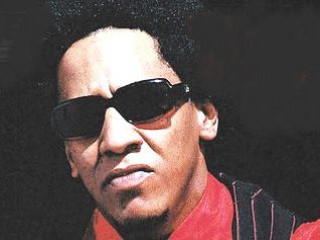
Tego Calderon biography
Date of birth : 1972-02-01
Date of death : -
Birthplace : Santurce, Puerto Rico
Nationality : Puerto Rican
Category : Arts and Entertainment
Last modified : 2011-10-21
Credited as : rap singer, actor, reggaeton
0 votes so far
As a child, he learned to play the bongo drums and the timbales. His grandmother gave him the nickname El Abayarde (or Aballarde, meaning "the fire ant"), which would later serve as his hip-hop moniker. Calderón moved to Florida as a teen, attending Miami Beach Senior High School and becoming interested in hip-hop music, especially in the socially conscious strand of the music exemplified by the group Public Enemy. Back in Puerto Rico, as a student at the Escuela Libre de Música conservatory, Calderón had little use for stage names. The school gave him a strong grounding in Puerto Rican traditional music that he would later put to use in stamping reggaeton with his own personal style. To pay his music school tuition bills, Calderón played in a rock band on the side.
Calderón, inspired by early Puerto Rican rapper Vico-C (known as "El Filosofo"), dreamed of introducing a distinctive version of mainland hip-hop to Puerto Rico. But he had a hard time of it at first. Even more than on the mainland, hip-hop was frowned upon by the Puerto Rican entertainment mainstream, and the music received little radio airplay or music industry support. Calderón worked at a variety of jobs and looked for a break. Spanish-language rap was flourishing in Los Angeles as a result of the efforts of Mexican-American artists, but in the Caribbean region it was rare. Calderón and other Puerto Rican rappers followed the lead of Panamanian artist El General.
In the early 1990s reggaeton began to take shape among young Puerto Rican clubgoers who added Spanish-language raps to Jamaican dancehall music. (The name "reggaeton" may have been derived from the words "reggae marathon," often used to advertise Jamaican dance parties.) Calderón disliked the music at first, with its hard, repetitive rhythms ("riddims" in Jamaica, "ritmos" in Puerto Rico) and its focus on sex and violence. But Calderón's father urged him to look at reggaeton as a path to wider popularity, telling his son, as Calderón recalled in the New York Daily News, "to go easy for people to accept you."
Calderón took his advice, and in the late 1990s began making guest appearances on albums by other artists in the young genre. Many of these tracks, written by Calderón himself, were later collected on Calderón's CD El Enemy de los Guasíbiri, These tracks attracted attention, and he was sought out by non-Puerto Rican hip-hop artists such as the Haitian-American Wyclef Jean. "I've got to do reggaeton in order to make people listen to my social stuff," Calderón explained to the New York Times. "I'm getting them to dance, and then I'm getting them to think a little bit." Calderón became a major attraction, but he still had no album of his own.
That changed when Calderón released El Abayarde in late 2002. The album was a mixed bag, with hints of Dominican merengue (Calderón numbered Dominicans as some of his strongest fans outside Puerto Rico) and a pure salsa track, "Planté Bandera," in addition to hip-hop. All Music Guide's Alex Henderson characterized El Abayarde as "an intriguing effort," and detected influences ranging from salsa king Willie Colón to progressive Panamanian musician Rubén Blades, to rapper Tupac Shakur. Calderón blended Afro-Cuban percussion into his sound, an important step forward for reggaeton, and the album became a smash. It sold over 150,000 copies in Puerto Rico alone, and suddenly, in March of 2003, Calderón was playing the 7,000-seat Roberto Clemente Coliseum in Puerto Rico. When the album was released on the United States mainland in the summer of 2003, it added tens of thousands more copies to its sales total. "You couldn't walk down a street in any of the city's sizable Puerto Rican or Dominican neighborhoods without hearing the beats of "Pa Que Retozen" or "Loiza," noted New York's Village Voice. Calderón was nominated for a 2003 Latin Grammy award, and a massive Reggaeton Summerfest at New York's Madison Square Garden in August of 2003, headlining Calderón and featuring 20 other reggaeton artists, drew a crowd of 12,000.
El Enemy de los Guasíbiri was issued as a follow-up and made its debut in the top five of Billboard magazine's Top Latin Albums chart in January of 2004. With sales muscle like that, Calderón became attractive to major advertisers such as cognac-maker Hennessy, which signed Calderón to a marketing deal in 2004. Calderón's career had been carefully shepherded along by a public-relations agency, Puerto Rico's Acisum Group.
Yet Calderón didn't lose his socially conscious edge. His lyrics often dealt with racism and social problems, and he sometimes said that he identified himself more as black than as Puerto Rican.
In the summer of 2005, Calderón signed a deal between Atlantic Records and his own independent label, Jiggiri Records, making him the first reggaeton artist to have a deal with a major record company.
In 2006, Calderón and both companies published The Underdog/El Subestimado. He noted that the production includes influence from several Afro-Caribbean rhythms including Reggae, Salsa, Bomba and Rumba. This production featured the guests appearances of Buju Banton, Voltio, Bataklán, Eddie Dee, Luis Cabán, Yandel, Zion, Chyno Nyno, Don Omar and Oscar D'León. Several producers were involved in the album, including Cookee, Major League, Salaam Remi, Eric Figueroa, Luny Tunes, DJ Nelson, Danny Fornaris, DJ Nesty, Naldo, DJ Joe, DJ Fat and Echo & Diesel. At the presentation party for the album, Calderón explained that he no longer considers himself as a reggaeton artist because this genre of music has become too commercial. Noting that reggaeton is becoming too similar to pop music and that he does not let his children listen to it at home unless it is on the radio.



















